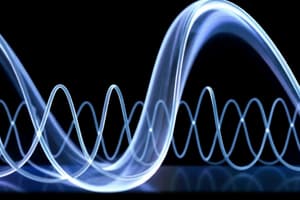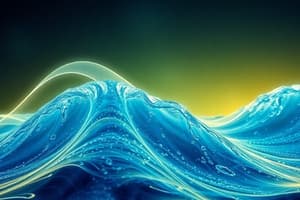Podcast
Questions and Answers
What is the direction of particle vibration in a longitudinal wave?
What is the direction of particle vibration in a longitudinal wave?
- In a circular motion around the direction of propagation
- Parallel to the direction of propagation (correct)
- Perpendicular to the direction of propagation
- At a 45-degree angle to the direction of propagation
Which of the following is an example of a transverse wave?
Which of the following is an example of a transverse wave?
- Earth's rotation around the Sun
- Sound waves in a gas
- Seismic P-waves in the Earth's interior
- Water waves on a lake (correct)
What is the term for the region of a longitudinal wave where particles are close together?
What is the term for the region of a longitudinal wave where particles are close together?
- Compression (correct)
- Crest
- Trough
- Rarefaction
What type of wave is characterized by particles oscillating in a direction perpendicular to the wave propagation?
What type of wave is characterized by particles oscillating in a direction perpendicular to the wave propagation?
Which of the following is an example of a longitudinal wave?
Which of the following is an example of a longitudinal wave?
Flashcards are hidden until you start studying
Study Notes
Waves and Energy
Types of Waves
Longitudinal Waves
- Definition: Waves in which the particles of the medium vibrate back and forth along the direction of propagation.
- Characteristics:
- Compressions: particles are close together
- Rarefactions: particles are far apart
- Particles oscillate along the direction of wave propagation
- Examples:
- Sound waves in a gas
- Seismic P-waves (primary waves) in the Earth's interior
Transverse Waves
- Definition: Waves in which the particles of the medium vibrate perpendicular to the direction of propagation.
- Characteristics:
- Particles oscillate in a direction perpendicular to the wave propagation
- Crests: highest points of the wave
- Troughs: lowest points of the wave
- Examples:
- Water waves (ripples) on a lake
- Light waves (electromagnetic waves)
- Seismic S-waves (shear waves) in the Earth's interior
Types of Waves
Longitudinal Waves
- Particles of the medium vibrate back and forth along the direction of propagation.
- Characterized by compressions (particles close together) and rarefactions (particles far apart).
- Particles oscillate along the direction of wave propagation.
- Examples include sound waves in a gas and seismic P-waves (primary waves) in the Earth's interior.
Transverse Waves
- Particles of the medium vibrate perpendicular to the direction of propagation.
- Particles oscillate in a direction perpendicular to the wave propagation.
- Waves have crests (highest points) and troughs (lowest points).
- Examples include water waves (ripples) on a lake, light waves (electromagnetic waves), and seismic S-waves (shear waves) in the Earth's interior.
Studying That Suits You
Use AI to generate personalized quizzes and flashcards to suit your learning preferences.




